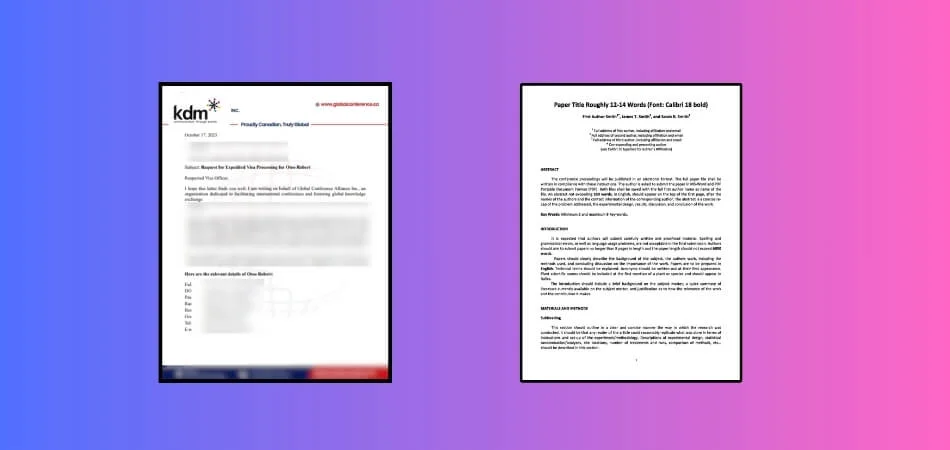The world of academic publishing can be daunting, especially when it comes to conference papers. At the forefront of this challenge lies a crucial question: “Is it difficult to publish a conference paper?”
No, generally. However, it is largely dependent on the stature and focus of the conference in question. High-profile conferences, known for their rigorous standards and high competition, present a formidable challenge to many researchers.
Conversely, smaller or more specialized conferences might offer a more welcoming platform for publication, especially for niche or emerging topics. To dig deeper into the intricacies of this journey and uncover effective strategies for successful publication, join us as we explore the landscape of academic conferences in the rest of this article.
What are Conference Papers?
Conference papers stand as essential elements in academic conferences such as international academic conferences, offering researchers a platform to present their findings and engage with peers. These papers are typically concise, focusing on novel research, and are presented at academic conferences. Their primary purpose is to spark discussion and feedback from the scholarly community.
In terms of structure, conference papers are often shorter than journal articles, emphasizing key points and findings. They serve as a precursor to more detailed publications in academic journals. Importantly, these papers offer early exposure to new ideas and methodologies, fostering collaboration and innovation within the academic community.
Significance of Publishing a Conference Paper
Publishing a conference paper is more than just a scholarly obligation; it’s a stepping stone in an academic’s research journey. It serves as a litmus test for new ideas, inviting critique and collaboration. This process plays a crucial role in the advancement of knowledge across disciplines.
- Conference papers act as a platform for presenting cutting-edge research, offering immediate feedback from peers and experts in the field.
- They enhance a researcher’s profile, showcasing their work to a wider academic audience, thus broadening their professional network.
- Publishing at conferences accelerates the dissemination of ideas, allowing for quicker integration of findings into ongoing research.
- Such publications often lead to collaborative opportunities, fostering connections that can result in joint research projects or publications.
- Conference papers contribute significantly to academic CVs, marking an individual’s active engagement in their field of study.
Publishing a conference paper is an invaluable experience for academics, catalyzing professional growth and scholarly contribution. It’s a practice that enriches both the individual and the academic community at large.
Is It Difficult to Publish a Conference Paper?
Determining the difficulty of publishing a conference paper is not a straightforward ‘yes’ or ‘no’ answer. The process varies significantly based on several factors, including the conference’s prestige and the paper’s subject area. It’s a multifaceted endeavor influenced by a range of elements.
Conference Prestige
- High-profile conferences have stringent selection criteria, making acceptance highly competitive.
- These conferences often receive a large number of submissions, increasing the challenge of standing out.
- The reputation of a conference often correlates with the difficulty of getting a paper accepted.
- Prestigious conferences are sought after for their impact and networking opportunities, further raising the bar.
Research Novelty and Quality
- The uniqueness and significance of the research play a crucial role in acceptance.
- Papers presenting groundbreaking findings or innovative methodologies are more likely to be selected.
- The quality of research, including methodology and data analysis, is rigorously scrutinized.
- Well-articulated, clearly presented, and thoroughly researched papers stand a better chance of acceptance.
Author’s Reputation and Network
- Established academics with a strong publication history may find it easier to get accepted.
- Networking within the academic community can influence the paper’s acceptance.
- First-time authors or those from lesser-known institutions might face additional challenges.
- However, exceptional research quality can override these barriers.
Alignment with Conference Themes
- Papers must align closely with the conference’s theme and objectives.
- Relevance to current trends and challenges in the field increases acceptance chances.
- Misalignment with the conference scope can lead to rejection, regardless of research quality.
- Tailoring the paper to the specific audience and theme of the conference is essential.
The difficulty of publishing a conference paper is influenced by a combination of factors. It’s a nuanced process where the prestige of the conference, the quality and novelty of the research, the author’s reputation, and the alignment with the conference theme all play crucial roles.
How to Publish Your Conference Paper Properly?
Publishing your conference paper involves several crucial steps to ensure it reaches the appropriate audience and maintains high academic standards. This guide will provide you with a structured approach to managing the publication process effectively. Each step is outlined with clarity and precision to help you succeed in your academic endeavors.
Step 1. Selecting the Right Conference
Before submitting your paper, research and choose a conference that aligns with your paper’s subject matter. A well-chosen conference increases the likelihood of your paper being accepted and appreciated by an audience interested in your field.
Step 2. Following Submission Guidelines
Every conference has specific guidelines for paper submission. Ensure you adhere to these requirements, which typically include formatting, word count, and referencing style, to avoid rejection on technical grounds.
Step 3. Crafting a Compelling Abstract
Your abstract is the first thing reviewers will read. It should succinctly summarize your research, including the problem addressed, methodology, and key findings, to engage the interest of the readers.
Step 4. Ensuring Originality and Relevance
Make sure your paper presents original research or novel viewpoints. Your work should contribute to existing knowledge and be relevant to the current trends and discussions in your field.
Step 5. Peer Review and Feedback
Once submitted, your paper will likely undergo a peer review process. Be open to feedback and ready to make revisions. This stage is crucial for enhancing the quality and credibility of your research.
Step 6. Final Submission and Presentation Preparation
After addressing the feedback, submit the final version of your paper. Additionally, prepare for the presentation at the conference, focusing on communicating your research effectively to the audience.
Step 7. Networking and Engagement
Use the conference as an opportunity to network. Engage with other researchers and attendees to discuss your work, gain insights, and establish professional relationships.
Step 8. Post-Conference Publication
Consider publishing your paper in academic journals or online platforms after the conference. This step increases the reach and impact of your research beyond the conference attendees.
Successfully publishing your conference paper requires careful planning, adherence to guidelines, and a commitment to producing high-quality research. This step-by-step guide is designed to assist you through each stage of the publication process, enhancing the visibility and impact of your work in the academic community. Remember, each step is an opportunity to showcase your research and contribute to your field’s body of knowledge.
Considerations While Publishing Your Conference Paper
When preparing to publish a conference paper, several key considerations are crucial for ensuring success and impact. These factors range from the quality of the content to the conference’s strategic choice. It is crucial to be aware of these considerations in order to improve your chances of your paper being accepted and well-received.
- Target Conference Selection: Choose a conference that aligns well with your research topic and audience for maximum impact and relevance.
- Research Originality and Depth: Ensure your paper presents novel ideas or significant developments in your field, emphasizing originality and depth.
- Adherence to Guidelines: Strictly follow submission guidelines, including formatting, word count, and citation style, to avoid rejection on technical grounds.
- Peer Feedback Incorporation: Seek and incorporate feedback from peers or mentors to refine and strengthen your paper’s arguments and structure.
- Presentation Skills: Develop strong presentation skills, as effectively communicating your findings is as crucial as the written content.
- Ethical Considerations: Adhere to ethical standards in research, including proper citation, avoiding plagiarism, and respecting confidentiality agreements.
- Timing and Planning: Be mindful of submission deadlines and allow ample time for revisions and feedback integration before the conference.
Successfully publishing a conference paper involves a careful blend of strategic planning, rigorous research, adherence to ethical standards, and effective communication. Paying close attention to these considerations greatly enhances the quality and impact of your academic contribution.
Tips to Avoid Any Mistakes While Publishing a Conference Paper
Publishing a conference paper is a meticulous process that demands attention to detail and adherence to specific guidelines. Common pitfalls can quickly derail the acceptance of a paper. Recognizing these pitfalls and preparing can significantly enhance the likelihood of successful publication.
- Thoroughly understand the conference guidelines; each has unique formatting, submission, and content requirements.
- Stay abreast of deadlines; late submissions are often outright rejected, so mark all relevant dates.
- Ensure your paper aligns with the conference’s theme; relevance is vital to be considered for presentation.
- Rigorously proofread your paper; grammatical errors and typos can undermine the credibility of your research.
- Cite sources correctly; improper citations can lead to accusations of plagiarism, jeopardizing your academic integrity.
- Keep your content concise yet comprehensive; overloading with information can dilute the impact of your key findings.
- Seek feedback from peers or mentors before submission; fresh eyes can spot issues you might have missed.
- Be prepared to revise; receiving feedback and suggestions for improvement is a standard part of the process.
Carefully preparing and submitting a conference paper can significantly reduce the risk of rejection. By following these guidelines, researchers can understand the submission process more effectively and increase their chances of success.
Final Thoughts
Publishing a conference paper, while challenging, is a manageable endeavor with proper preparation and awareness of the intricacies involved. The difficulty of this task, often encapsulated in the question, “Is it difficult to publish a conference paper?”, largely depends on the conference’s prestige, the novelty of the research, and the adherence to submission guidelines.
Accurate and thoughtful completion of the application is paramount to avoid rejection. Should errors arise, promptly following the necessary steps for correction is crucial. Neglecting these aspects can lead to missed opportunities and diminished academic credibility.
Ultimately, the process not only demands rigor in research and presentation but also meticulous attention to administrative details, ensuring a successful and impactful publication.








